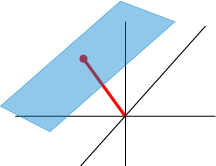Section2.1Portfolio 2
¶Portfolio 2: Vectors and Transformations is due to Blackboard by 11:59 p.m. Friday, June 22nd.
Subsection2.1.1Purpose and Learning Standards
The second portfolio forms the heart of the course. In it, you'll pass from thinking about the objects of linear algebra as being "equations and unknowns" to thinking instead about "vectors and matrices:" seeing every linear system of equations as having the form \(A{\bf x} = {\bf b}\) for some matrix \(A\) and vector \({\bf b}\text{.}\) It is here where you'll study the most fundamental objects, relationships, and properties of vectors, vector spaces, and linear transformations from both computational and conceptual standpoints.
The learning standards included in this portfolio are:
- 2.A Perform algebraic operations on vectors (addition and scalar multiplication).
- 2.B Perform algebraic operations with matrices including addition, subtraction, scalar multiplication, matrix multiplication, and transposition.
- 2.C Determine the inverse of a square matrix using Gaussian elimination and use the inverse to solve a linear system.
- 2.D Determine if a given vector is a linear combination of a given set of vectors.
- 2.E Find a basis for the row space, column space, and null space of a matrix.
- 2.W Model phenomena using vectors and matrices, and solve applied problems.
- 2.X Determine whether a subset of a vector space is a vector subspace (or not).
- 2.Y Determine whether (or not) a set of vectors is linearly independent, a spanning set for a given subspace, and/or a basis for that subspace.
- 2.Z Demonstrate theoretical connections related to matrix algebra, especially those related to invertibility of a matrix, its rank, and its nullity.
Subsection2.1.2Skills You'll Develop
In this portfolio you'll gain practice with the following skills that will not only promote your success in linear algebra, but grow as practitioners of pure and applied mathematics.
- Translating linear systems of equations, and subsets of \(\mathbb{R}^n\text{,}\) between coordinate forms and vector forms.
- Expressing the solution set of a linear system of equations in parametric vector form.
- Using the row-echelon properties of a matrix to investigate properties of its columns (or rows) as a set of vectors.
- Determining a basis for a vector subspace, and using the concept of basis to precisely define and discuss the notion of dimension.
- Discover situations in which the abstract properties which define a vector space hold for sets that are not \(\mathbb{R}^n\text{,}\) and use linear algebra to solve problems in those settings.
- Connect the pivot properties of a matrix with important functional properties (e.g., one-to-one, onto) of its associated linear transformation.
- Write clear, careful proofs of elementary mathematical facts that connect two or more related properties of a matrix (or vector space or linear transformation).
Subsection2.1.3Knowledge You'll Gain
In this portfolio you'll gain familiarity with the following important content knowledge of linear algebra.
- Vector spaces (general, abstract definition)
- Vector operations in \(\mathbb{R}^n\)
- Matrix algebra
- Fundamental Theorem, Part I: Matrix multiplication is a linear transformation
- Linear independence of a set of vectors
- Spanning set of a vector subspace
- Basis of a vector subspace
- Column space of a matrix (= range of a linear transformation)
- Null space of a matrix (= kernel of a linear transformation)
- Rank and nullity of a matrix, and the Rank-Nullity Theorem
- Inverse of a (square) matrix
- Invertible Matrix Theorem
Subsection2.1.4Tasks
You'll demonstrate that you've fulfilled the purpose of this assignment by completing the following sets of tasks. Each type of task will generate an artifact that you can include in your portfolio.
- Begin your Learning Narrative 2 (click here for more information)
- Engage regularly with your classmates through reading discussions, Flipgrid assignments, Piazza discussions, and/or online gatherings.
- Practice problem solving in WeBWoRK (click here to access)
- Submit, and revise based on feedback, quizzes and exams via Blackboard (click here to access)
- Type up, and revise based on feedback, solutions to a selection of proof exercises via Blackboard (click here to access)
- Complete the first Pecha-Kucha project (click here for more information) and submit video to Blackboard.
- When finished with the above, complete your Learning Narrative 2 (click here 3 for more information).
- Finally, submit your finished portfolio by the due date via Blackboard (click here to access).
Subsection2.1.5Criteria for Success
Your portfolios in this course are the primary component on which you are graded. Accordingly, your portfolio must contain evidence that you have done each of the following:
- Met each computational learning standard listed above (2.A, 2.B, 2.C, 2.D, 2.E). For each standard, evidence must include one or more quizzes, exam problems, and/or copies of fully worked-out sets of WeBWoRK exercises related to these standards.
- Met each conceptual learning standard listed above (2.W, 2.X, 2.Y, 2.Z). Evidence must include your typeset proof portfolio problems (as a PDF).
- Engaged with your classmates around coursework. Evidence must include screenshots or printouts of one or more discussions within reading annotations or on Piazza, and/or a discussion of your contributions to video boards or online hangouts.
- Reflected on the progress of your own learning. Evidence must include your Learning Narrative at the front of your portfolio, which explicitly references how the other evidence in your portfolio supports your having done all of the above.
